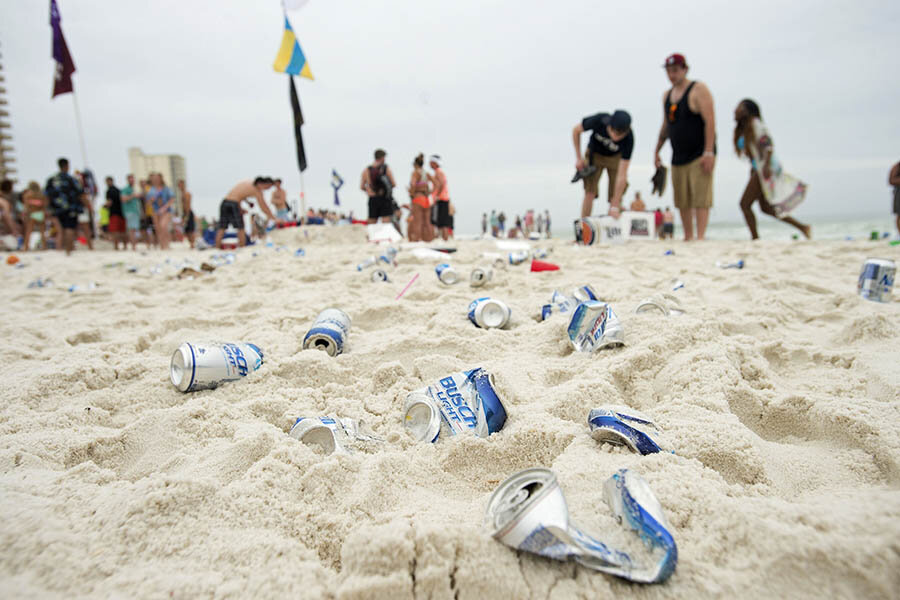Teen drinking linked to alcohol in movies: studies spark calls for change
New studies linking the rising prevalence of alcohol in movies to teen drinking are leading to calls for alcohol to become the "new tobacco."
As part of its settlement with states in 1998, the tobacco industry agreed to stop paying for product placement in films, and images of smoking in films dropped. Now, public health officials and activists are pushing for a similar cutback on alcohol use in films and advertising. [Editor's note: The original version of this paragraph gave the incorrect year for the tobacco settlement.]
A new report from Britain adds to a growing body of evidence that suggests that teens who watch many movies with alcohol scenes begin drinking earlier than their peers, and are also more likely to binge drink. The study, published Monday in the online version of the journal Pediatrics, found that 15-year-olds who had the highest exposure to alcohol use in films were far more likely to have tried alcohol and to binge drink than those with the least exposure – even controlling for other variables, such as familial alcohol use and parental monitoring.
The findings mirror similar studies from the United States. Other research has found an increase in alcohol consumption among teens who see beer and liquor ads on television, who are more exposed to in-store alcohol ads and who own alcohol-branded clothing.
While alcohol industry officials push back with studies of their own – including a recent University of Texas report that found little change in American alcohol consumption despite a 400 percent increase in alcohol advertising – public health officials say the growing evidence points to the need for action.
“The research findings are mostly consistent and difficult to ignore: the more young people are exposed to alcohol marketing of various kinds, the more likely they are to begin drinking sooner and to drink more if already drinking,” says David Jernigan, director of the Center on Alcohol Marketing and Youth at the Johns Hopkins Bloomberg School of Public Health.
“Where we are in alcohol right now is pretty much where we were in tobacco in 1989,” adds James Sargent, professor of pediatrics at the Geisel School of Medicine at Dartmouth College.
There have been attempts across the country to curb alcohol advertising on public transit, near schools, and even during the Super Bowl, and recently the US Federal Trade Commission launched a new study of the way the alcohol industry markets on social media.
There has been international movement, as well. Finland, for instance, recently instituted a series of new restrictions to reduce the alcohol advertisements seen by children. South Africa is debating alcohol advertising bans, as are other countries in sub-Saharan Africa. And the World Health Organization says restricting alcohol marketing is a key way to reduce alcohol-related health problems.
US health officials say Monday’s study is of particular concern because American teens’ exposure to alcohol scenes in movies, as well as in advertising, is on the rise.
“This study is completely on point. It’s almost a no-brainer for parents and educators,” says Jim Steyer, CEO and founder of Common Sense Media, a national nonpartisan organization dedicated to improving media for families and kids. “It’s not a shock that after watching some of the films out there that a teen would experiment with alcohol. What is a true shock is that the media and entertainment industries are not held accountable for targeting inappropriate content to kids.”
Two years ago, researchers with the Norris Cotton Cancer Center published a study in which they catalogued the top 100 US box office releases for each year between 1996 and 2009. While the number of tobacco brand appearances dropped, the alcohol brand appearances increased, particularly in youth-rated movies, where they jumped from 80 to 145 per year.
Today, he says, alcohol product placement works about the same way as tobacco placements once did, with “multinational companies with big advertising budgets funneling funds and products into the movie industry, and the movie industry saying ‘thank you very much’ and incorporating products and behaviors into the movies.”
But industry representatives bristle at the comparison.
Alcohol, they say, is a healthy and accepted part of life for a huge number of Americans. And in an recent opinion piece, the managing director of the American Beverage Institute, Sarah Longwell, contested the research linking alcohol advertisement with teen drinking, and points out that underage drinking is down.
“Alcohol advertisements steer drinkers to different types of brands and products and have little influence over whether or not an individual will drink,” she wrote.
While health officials and children’s advocates say they would like more tobacco-style regulation, they acknowledge that fighting for alcohol advertising restrictions will be an uphill battle, as will be convincing the Motion Picture Association of America to consider more seriously alcohol use in its ratings.
Parents, however, can start to step in where regulations fail, they say.
Claire McCarthy, a member of the American Academy of Pediatric’s council on Communications and Media, says that her organization is working to figure out new ways to partner with the media industry, and to also give parents additional resources for dealing with media messages.
She says that she often sends parents to Common Sense Media’s reviews of movies, apps, and other media, which include descriptions about everything from alcohol content and violence to overall quality.
“These are the kind of tools that we need to promote,” she says. “We probably aren’t going to get the film industry to make everything squeaky clean, but we need to do a better job about getting information to parents about what’s in movies, and to empower parents.”






